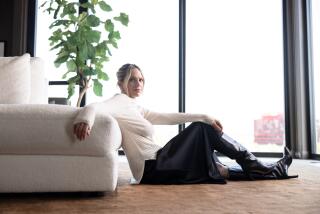Jewish Living magazine launches with a niche in mind
- Share via
Pass a magazine stand these days and you’re likely to see Martha Stewart Living, Oprah at Home, Southern Accents, Country Living, Cottage Living.
Make room for Jewish Living, a lifestyle magazine aimed at well-educated Jewish women ages 25 to 54 with children at home and a household income conservatively pegged at $125,000, says publishing director Daniel Zimerman.
“Like a Martha or Oprah magazine for the Jewish community,” he says, this bimonthly follows the formula of “personalities, recipes and homemaking. While they do Christmas and Easter, we do Hanukkah and Passover: the blessings, the traditions.”
Potential readers include the nonobservant who consider themselves culturally Jewish, as well as straight and gay interfaith couples and modern Orthodox Jews.
The magazine (sold at Barnes & Noble and www.jewishlivingmag.com) fills a niche similar to the one Essence and Ebony fills for African Americans and Latina for Latina women, Zimerman says.
And yes, other religions also have their own periodicals. Faith & Family, a self-described “magazine of Catholic living,” gives readers features about home, food, finance and keeping the romance in marriage. LDS Living, a publication for Mormons, covers much of the same ground.
The timing is right because “there is a real sense of a renaissance in the Jewish community,” says Zimerman, a Canadian who moved to New Jersey with his wife to launch the magazine. “There is a distance from the immigrant community. We are more mainstream. My father-in-law in Toronto still puts his mezuza on the inside of his house so his neighbors won’t see it.”
The November-December debut issue has a story called “Mezuza 101,” tracing the history of putting a Hebrew prayer inside a case and affixing it to a doorjamb. Easy instructions encourage the practice. The issue is also long on Hanukkah: eco-friendly and charitable gift-giving, party-planning tips and gourmet latke recipes. But don’t look for articles on the Palestinian conflict or whether interfaith marriage threatens the future of Judaism. Other Jewish magazines (Tikkun, Moment) tackle such controversies, Zimerman says.
And he doesn’t foresee stories on Jewish furniture makers or designers, although there will be a focus on holiday decorating. “Clearly for Passover, for Hanukkah, there will be ways to decorate the mantel, dining-room table, the entranceway. There are also traditional Jewish religious items that become part of the home decor,” he says.
But he rules nothing out.
“Just like Hanukkah is the festival of light, there may be an opportunity on how to bring more light into the home. For Tu B’Shevat, the new year for the Earth and trees, we could do something on gardening or potting plants in the home.”


